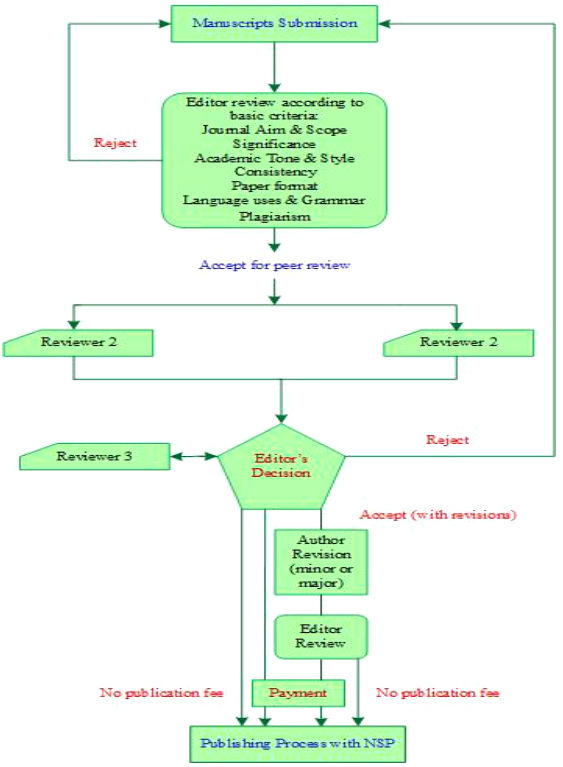|
Reviewer Recruitment IJTFST welcomes scholars and researchers to join us as peer reviewers of manuscripts being considered for publication in a scholarly international journal that covers technology management, sustainability, business, management, environment, climate, transportation and communication. The peer review process serves two primary purposes, reviewers advise editors on which papers to include in their journal and provide constructive feedback to authors to improve the quality of their publications. Thus peer review process guarantees the high quality of articles published. Reviewer Job Description Joining the peer review team is definitely important to the success and reputation of the journal. Reviewers and editors collaborate to select significant and high quality manuscripts to be published. Thus the published work will have impact on literacy in national and international classrooms. Peer reviewers are internet-based, part time volunteers whose working language is English. Their main tasks are to review manuscripts and then recommend whether it should be rejected, accepted as is, or accepted with revision. Peer reviewers should provide advice to editors to help them in their publication decision. Peer reviewers should provide constructive feedback to authors that would help them improve the quality of their publications. Reviewers must also report to editors any issues relating to author misconduct, such as plagiarism. Peer reviewer is a voluntary job that doesn’t offer salaries but reviewer name will be listed in the printed journal and on the journal’s webpage. Reviewer Requirements - Doctoral degree in a field close to that of the journal.
- Academic position i.e. teaching or research at university.
- Fluent in academic and professional English.
- Interested in the scholarly journals.
- Work hard and meet deadlines.
- Reviewers are required to follow the Committee on Publication Ethics (COPE). COPE Ethical Guidelines for Peer Reviewers
Benefits of Being A Reviewer - Enhancing evaluation skills.
- Being the first to see new materials.
- Listing as an Editorial Board member in the print journal and on its website.
- Strengthening your resume for promotion or academic position.
- Assisting the journal to Publish a high quality work.
- Helping authors to produce high quality papers.
- Gaining a sense of prestige in being consulted as an expert.
- Enabling you to conduct a good, rigorous peer-review process.
- Updating your awareness of the emerging research within your field.
- Strengthening your academic and professional record.
- Enabling discussion between author, reviewer, and editor around a research field or topic.
- Enhancing writing skills and detect your own errors.
Writing A Review Browse the journal website and read the aim, scope, author guidelines and peer review guidelines. This will help you in deciding whether the manuscripts being reviewed is fit and comply with the journal contents. - Refer to author Guidelines to check if the manuscript meets the submission criteria.
- Refer to the peer review guidelines to follow the process step by step. This will help you in reviewing and writing reports and ultimately meet the deadlines.
- Refer to author Guidelines to check if the manuscript meets the submission criteria.
- Refer to the peer review guidelines to follow the process step by step. This will help you in reviewing and writing reports and ultimately meet the deadlines.
Write your review Read the manuscripts thoroughly and write a summary then assess its quality and compliance with journal guidelines. Make a recommendation to the editor regarding publication: - Accept if the paper is comply to journal guidelines and suitable for publication in its current form.
- Minor revision if the paper needs light revisions. Attach the list of revisions you would recommend the author makes.
- Major revision if the paper needs substantial changes i.e. rewriting sections, widening literature review, and expanding data analysis.
- Reject if the paper is not suitable for publication with this journal i.e. doesn’t comply with the basic guidelines and not suitable for publication in its current form.
Note About Revision In response to reviewer comments, author makes revisions to his paper. Author lists the changes and any comments then submit them the reviewer i.e. revised version returned to the original reviewer. confirm whether the revisions have been carried out correctly. Type of Review This journal follows the single-blind peer review in which the reviewers’ identity is kept anonymous from the authors. That means authors don’t know the identity of who reviewed their paper, but reviewers know the authors’ identity. single blind review allows the reviewer to critique a paper without any influence by the author. Making reviewer’s identity known to authors or to the public will impact reviewers opinion and may not give their true opinion in case it is perceived as too critical. Knowing their name will be kept anonymous gives reviewers the freedom to say what they really think. Single blind review is the most widely used form of peer review, a survey by the Publishing Research Consortium found that 85% of respondents had experienced single-blind review. Peer Review Process All manuscripts submitted to HexaTech are subjected to peer-review. The peer review follows step-by-step procedure: - Once the manuscript is received, it is delivered to two qualified reviewers.
- Reviewers have two weeks to review the manuscript and to advise editor on the acceptance, acceptance with revision, or rejection.
- Editor turns the accepted manuscript with revision to the corresponding author.
- Authors handle the reviewer recommendations and make any suggested changes in the manuscripts and return it to the editor by email.
- The editors send back the corrected and reviewed manuscripts to the Editor-in-Chief, and also delivers the manuscript to different editors.
- The Editor-in-Chief coordinates the editorial procedure and distributes the articles submitted to the journal.
ReviewerPeer Review Flowchart 
|